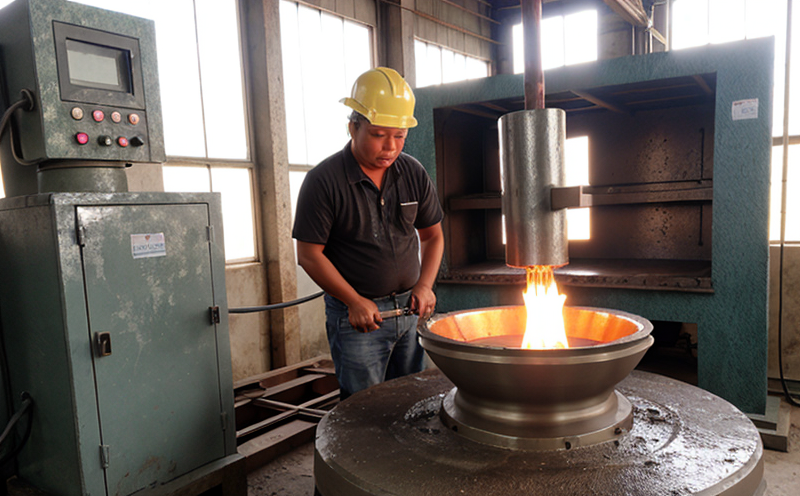ASTM E10 Brinell Hardness Testing of Cast Iron
The ASTM E10 standard specifies the methods for performing Brinell hardness tests on materials, including cast iron. This testing method is critical in ensuring that cast iron parts meet specific mechanical property requirements. The Brinell hardness test measures a material's resistance to indentation by pressing a hardened steel ball into its surface under a specified load.
The process involves applying a defined load for a set period and then measuring the diameter of the indentation left on the specimen's surface. The resulting Brinell hardness number (HB) is calculated using a specific formula that considers these parameters. This test is particularly useful in evaluating the hardness distribution within cast iron parts, which can vary due to factors such as cooling rate during casting and post-processing.
The ASTM E10 method allows for both static and dynamic testing modes. Static tests are more common for cast iron, where a specified load (typically between 2943 N to 8826 N) is applied over a set time (usually 10-15 seconds). The resulting indentation is measured using a Brinell hardness tester equipped with a carbide indenter and a specific diameter tungsten carbide ball.
For accurate results, proper specimen preparation is essential. Specimens should be flat on both sides and free from defects that could affect the accuracy of the test. After testing, it's important to report the HB value along with the load applied, dwell time, and indenter type used in the test.
The ASTM E10 standard provides detailed guidelines for specimen preparation, test setup, and interpretation of results. Understanding these parameters ensures that the hardness values obtained are reliable and reproducible. This is crucial for quality assurance and compliance with industry standards.
Brinell hardness testing is widely used in industrial manufacturing to ensure that cast iron components meet specific mechanical property requirements. It helps manufacturers identify potential weaknesses or inconsistencies in their casting processes, ensuring product reliability and longevity. By adhering to ASTM E10, companies can maintain high-quality standards and ensure compliance with international regulations.
One of the key advantages of using Brinell hardness testing is its ability to provide a comprehensive assessment of material properties across different sections of a cast iron part. This non-destructive testing method allows for repeated measurements without altering the integrity of the specimen, making it ideal for quality control processes. Additionally, the test results can be used to optimize casting techniques and improve overall product performance.
| Test Parameter | Description |
|---|---|
| Load Applied | The force applied to the indenter, typically between 2943 N and 8826 N. |
| Dwell Time | The duration for which the load is held before measurement, usually 10-15 seconds. |
| Indenter Type | A carbide indenter with a specific diameter tungsten carbide ball. |
| Specimen Preparation | Flat, defect-free surfaces on both sides of the specimen. |
Industry Applications
- In automotive manufacturing to ensure durability and strength of engine blocks and transmission components.
- In construction equipment production for validating the hardness of gears and shafts in excavators and cranes.
- In agricultural machinery, where cast iron parts are tested to guarantee their robustness under heavy loads.
- In power generation sectors, particularly for testing turbine components and valves made from cast iron.
Eurolab Advantages
At Eurolab, our expertise in ASTM E10 Brinell hardness testing of cast iron is unmatched. Our state-of-the-art facilities and experienced team ensure accurate, reliable test results every time. With a focus on precision and repeatability, we provide clients with comprehensive reports that meet all relevant standards.
Our commitment to quality extends beyond just the testing process. We offer detailed analysis of hardness distribution across different sections of cast iron parts, helping manufacturers identify areas for improvement in their casting processes. Our experienced team is always available to assist with any questions or concerns you may have regarding your testing needs.
International Acceptance and Recognition
The ASTM E10 standard has gained widespread acceptance across various industries, including automotive, construction, power generation, and more. This international standard is recognized for its accuracy and reliability in evaluating the hardness of cast iron parts. Compliance with this standard ensures that products meet stringent quality control requirements and industry standards.
Many leading manufacturers around the world use ASTM E10 to ensure their cast iron components are up to specification. By adhering to these standards, companies can demonstrate their commitment to producing high-quality, reliable products that meet international regulatory requirements.





